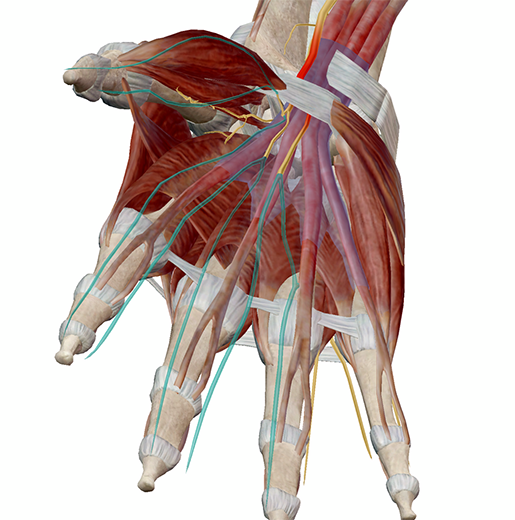Into the Carpal Tunnel: Prevention and Treatment of CTS
Posted on 9/28/12 by Courtney Smith
In our previous post, we took a look at the dreaded carpal tunnel syndrome, bane of hand-users everywhere, as well as some preventative measures.
To recap, everyone has a carpal tunnel. The carpal tunnel is a, well, tunnel formed by the bones of your wrist and the flexor retinaculum. Through this tunnel pass the flexor tendons of your hand, as well as the median nerve, which supplies sensation to all your fingers with the exception of the little one. Carpal tunnel syndrome (CTS) occurs when the tendons swell from overuse and press against the median nerve, which results in pain or numbness. In some cases, the opposite occurs and the nerve swells. Not everyone will suffer from CTS, but 3% of women and 2% of men will in their lifetime. Allowing rest breaks for your hands and focusing on ergonomics can do wonders in preventing CTS from taking hold.
 Image captured from Muscle Premium.
Image captured from Muscle Premium.
But what if you did have a full-blown case of CTS? Preventative measures might not be enough to solve the problem or even ease the symptoms. Some studies show that surgery is the best option for dealing with CTS, but there are other things to try before bringing out the big guns.
Treatments
The easiest (and cheapest!) treatment option is to limit the movement of your wrist for anywhere from two to six weeks. Wrist braces or splints (available in any drugstore) are a great prescription for this; they keep the wrist from bending. Some people (like my stubborn mule of a grandmother) think it's a good idea to work through the pain of an ailment. Not the case with CTS. By limiting movement, the swelled tendons in the wrist have a chance to go down and relieve the pressure on the nerve.
Corticosteroids are another option. Either taken orally or injected directly into the carpal tunnel, corticosteroids will shrink the inflamed tissue. However, while they may provide quick relief, the effects are not permanent. Corticosteroids will last anywhere from one to six months. Injections after the first one don't tend to have much effect and can result in nerve damage, which is why doctors are hesitant to prescribe this treatment and limit injections to one to two per year.
Ultrasound treatment, combined with nerve exercises, is also employed in reducing the swelling of the tendons. The effectiveness of this treatment is still being researched. Ultrasound treatment involves a series of high-frequency sound waves that are aimed at an inflamed area. The deep tissues of the body convert the sound waves to heat, which opens the blood vessels wider and allows more oxygen to be delivered to the damaged tissue.
Surgery
If nonsurgical treatments fall flat and the CTS is severe enough, there is the option of surgery. Doctors will want to establish a patient's candidacy for surgery first. Candidates will normally be over the age of 50 and have symptoms that have lasted over a 10-month period, continual numbness of the wrist and hand, and muscular atrophy in the hand. Once candidacy is established, the patient can go ahead with the surgery.
The surgery itself is pretty straightforward. It is an outpatient surgery, which means the duration of the procedure is short and the patient can go home the same day. The surgery is an open-release surgery, which targets one specific ligament. The surgeon will access the wrist and sever the ligament to relieve the pressure on the median nerve.
Before you read on, take a look at this nifty 20-second video that shows what the surgery does. (No audio)
The ligament that you see severed during this surgery is the flexor retinaculum. This ligament is a fibrous band that allows movement but does not stretch. When the tendons swell and press against the median nerve, they push it up against the retinaculum. It's like being crushed against a wall.
Recovery time is anywhere from two weeks on. The scar on the wrist will be tender for a while and some patients report a loss in manual dexterity. However, the symptoms of pain and numbness are usually alleviated immediately and patients return to peak performance around 10 months, post-op.
Some complications may arise in the long term, such as scarring and infection (which are risks with any surgery), as well as stiffness and pain. In some cases, repeated operations are needed if the symptoms return—the retinaculum may not have been completely severed, or an underlying medical condition could be causing issues. Like with so many treatments, nonsurgical options are the first technique to try!
So if you're experiencing the symptoms of CTS, don't let them worsen: rest your hands! Even if that means you need to stop searching for funny cat videos on YouTube for a little bit.
Be sure to subscribe to the Visible Body Blog for more anatomy awesomeness!
Are you an instructor? We have award-winning 3D products and resources for your anatomy and physiology course! Learn more here.
Related Posts:
Additional Sources:




